Technology
PROPERTY| ROTATIONAL MOULDING
Rotational molding is an atmospheric pressure process that produces nearly stress-free parts. The fact that there are no stresses on the melt as it is shaped is a major advantage that rotational molding has over all other manufacturing methods for plastics parts. Also, as there are no forces on the plastic melt during forming, rotational molds can have thin walls and are relatively inexpensive to fabricate. For simple parts, mold delivery times can be a few days or weeks. Modern, multi-armed machines allow multiple molds of different sizes and shapes to be run at the same time. With proper mold design, complex parts, such as double-walled containers, that are difficult or impossible to mold by any other method, can be rotationally molded. With correct process control, the wall thickness of rotationally molded parts is quite uniform, unlike structural blow molding or twin-sheet thermoforming.
HOLES
Holes can be created in several ways, using: Through pins, Cores, Insulation panels and Knife edge.
Care must be taken to provide the necessary draft angles and an adequate heat transfer. To improve the heat transfer the core must be produced with half on one section of the mould and half on the other section. Where ever possible a hole should be included inside the core to further improve the air flow.
These are used to thermally insulate areas of the mould and create colder areas where the material does not adhere to the surface of the mould. To obtain this, a sheet of PTFE (Teflon) or a mineral wool layer is usually used. They are designed smaller than the required hole since the immediately surrounding area will have a thinner wall (which will be removed).
